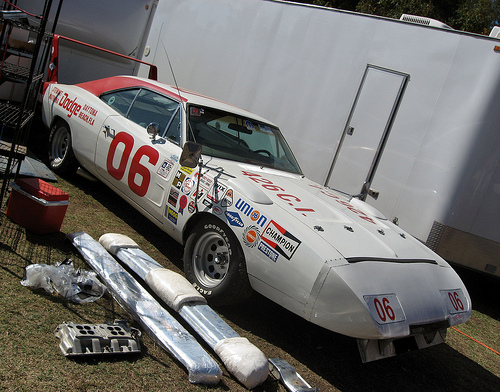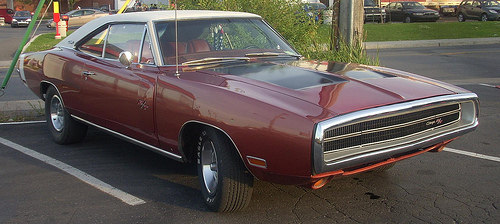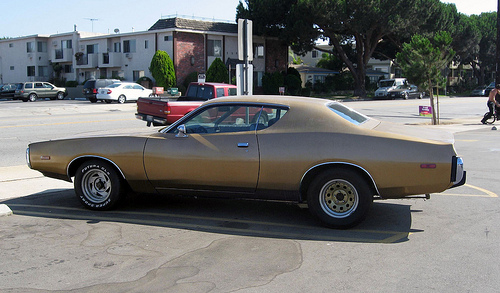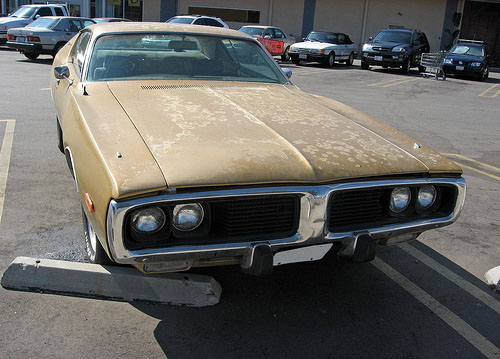WIN OR DIE
On September 9, 1969, five days before the Talladega 500, project engineer Larry Rathgeb and driver Charlie Glotzbach took the Charger Daytona test mule to the track for qualification. Despite competition director Ronald Householder’s strict orders to keep speeds below 185 mph (298 km/h), Glotzbach blew through his laps at more than 199 mph (320 km/h). It was a dramatic demonstration of what the Daytona could do.
In the Daytona’s racing debut on September 14, driver Richard Brickhouse proved that early performance was no fluke, winning the inaugural Talladega 500 with lap speeds of up to 197 mph (317 km/h). Brickhouse’s victory was slightly hollow because 30 top NASCAR drivers, including Glotzbach and Richard Petty, had boycotted the race in a dispute over track safety. Nonetheless, the race was an impressive showing for Dodge.

This Dodge Charger Daytona is the real thing: Neil Castles’ #06 NASCAR racer, now privately owned. Its 426 Hemi engine is very similar to the street Hemi, but has higher compression, aluminum heads, and a single four-barrel carburetor. Naturally, it makes a good deal more horsepower than the street engine’s 425 gross hp (317 kW).
The Charger Daytona was not invincible, but it was a formidable competitor. Not only was faster than its rivals, it was very stable at high speeds, a huge improvement over the earlier Chargers. Dodge’s drivers and engineers also had an additional, less-quantifiable edge: their mortal fear of Bob McCurry. Gary Romberg later recalled that some Charger Daytona drivers mounted a photo of McCurry on the dashboards of their cars with a caption reading “Win or Die.”
Unfortunately, the Daytona arrived too late in the season to overcome Ford’s early lead. Although Dodge earned 22 victories, Ford again took the 1969 Manufacturers’ Championship on points. Moreover, Plymouth enticed Richard Petty back from Ford for the 1970 season by promising to build him a winged car of his own based on the Plymouth Road Runner. The Daytona’s thunder was about to be stolen.
Dodge’s pride was somewhat assuaged by a publicity stunt staged at the suggestion of public relations director Frank Wylie. On March 24, 1970, before an audience of NASCAR officials, Buddy Baker drove the Charger Daytona development mule to a new lap-speed record at Talladega: 200.45 mph (322 km/h).
THE 1970 DODGE CHARGER
Meanwhile, the standard Charger returned for the 1970 model year with another modest facelift, distinguished mainly by a new grill with a loop-type front bumper. Curiously, the Charger 500 was back, although it was now just a mid-level trim series with none of the previous aerodynamic improvements. A new option was the 440 cu. in. (7,206 cc) “Six Pack” engine with an Edelbrock aluminum intake manifold and three Holley two-barrel carburetors. Dodge rated it at 390 gross horsepower (291 kW), which some reviewers thought was conservative. The four-barrel 440 and 426 Hemi remained optional.

A 1970 Charger R/T shows off its new grille treatment. (Photo: “Dodge Charger R-T (Orange Julep)” © 2008 Bull-Doser; released into the public domain by the photographer, resized by Aaron Severson)
Despite the heavy artillery, Charger sales dropped by nearly 50% for 1970, failing to top the 50,000 unit mark. The main reason was higher insurance rates, which were making intermediate Supercars too expensive for many buyers. There was also internal competition from the new Dodge Challenger pony car, which offered the same engines as the Charger, cost and weighed somewhat less, and had fresher styling. The Challenger didn’t sell particularly well either, but it probably cannibalized a substantial number of Charger sales.
Production of the Charger Daytona ended in September 1969, after the homologation minimum had been reached. Although the Daytona and its Road Runner Superbird cousin are prized collectibles today, they were not easy to sell when new and leftovers languished on dealer lots for months, despite substantial discounts.
Nonetheless, the winged cars had served their purpose and NASCAR Daytonas continued to race with great success. Despite strong competition from Richard Petty’s new Plymouth Road Runner Superbird, Bobby Isaacs drove a Charger Daytona to the 1970 Grand National Division Championship and Dodge beat out both Plymouth and Ford for the 1970 Manufacturers’ Championship. Buddy Baker’s closed-course speed record stood for 13 years, finally being broken in 1983 by Benny Parsons.
1970 would be the last season for the winged cars. Dodge and Plymouth did some preliminary work on a new generation of winged B-bodies, but they didn’t get very far. NASCAR boss Bill France, who had never liked limited-edition homologation specials, ruled that winged cars would henceforth be restricted to engines of no more than 305 cu. in. (5,000 cc) displacement. Realizing they would have no chance with smaller engines, the Dodge and Plymouth teams switched back to conventional bodies.
THE GLORIFIED CORONET: THE 1971-1974 CHARGER
Around the time the Charger Daytona’s racing career was winding down, Dodge unveiled the restyled 1971 Charger. It was the most dramatic iteration of Chrysler’s new “fuselage styling” theme — curvaceous but massive-looking, with radical tumblehome (inward angle of the roof sides) and a colossally long hood. The Charger was actually shorter than before, but it was 3.5 inches (89 mm) wider, making it feel even bigger than it was. Car and Driver proclaimed it the year’s best-looking car, likening it to the work of sculptor Frank Gallo, but other critics were dismayed by the new Charger’s intimidating bulk.

In 1971, Chrysler adopted a split-wheelbase strategy for its B-body intermediates, just as GM had done in 1968. Four-doors intermediates rode a 118-inch (2,997mm) wheelbase, one inch (25 mm) longer than before, while two-doors rode a 115-inch (2,921mm) wheelbase, 2 inches (51 mm) shorter than before.
The Charger’s look was a clear evolution of the second-generation car, but its role in the Dodge lineup had changed. When the 1971 model was originally conceived in the late sixties, Bob McCurry and Burt Bouwkamp had noted that sales of the regular B-body Coronet had slackened considerably. Since the Charger was essentially a better-looking B-body hardtop, they concluded that many Charger sales probably came at the expense of the Coronet. The simple solution was to drop the slow-selling Coronet coupes and hardtops and apply the Charger name to all two-door Dodge intermediates.
On its face, this seemed like a sensible merchandising decision, but it continued a regrettable Detroit tendency to dilute desirable nameplates in the search for greater volume. Chrysler was hardly alone in that predilection — the Chevrolet Bel Air and Pontiac Bonneville (to name just two examples) had been similarly demoted — but the Charger had been the closest thing Dodge had to a halo car, particularly since the E-body Challenger was shaping up to be an expensive flop.
Based on the sales figures, the consolidation either confused or turned off more Dodge buyers than it enticed. Total Charger sales rose to more than 82,000 for 1971, but that was actually about 20% less than the previous year’s combined sales of the Charger and two-door Coronet.

The 1971-1974 Charger continued the loop bumper theme introduced in 1970. The large rubber bumper overriders were added in 1973 to meet federal 5 mph (8 km/h) crash standards.
The Charger line now boasted two performance models: the R/T and the Super Bee econo-racer (Dodge’s answer to the Plymouth Road Runner, previously part of the Coronet line), both of which were available with the 440, 440 Six Pack, or 426 Hemi. Emissions controls were beginning to erode engine power, but all were still strong performers. It hardly mattered; high insurance rates had made the Supercars virtually unsalable. The Super Bee accounted for only about 5,000 sales in 1971, the Charger R/T about 3,100. Both models were dropped at the end of the year.
The 1971 model year was also the last bow of the 426 Hemi. It had never been produced in large numbers — total production from 1964 to 1971 was something like 16,000 units for both Dodge and Plymouth — but its presence had always added a certain luster to Chrysler’s performance image. With minimal sales and ever-more stringent emissions standards, however, Chrysler decided it was no longer worthwhile. Production ended in the summer of 1971.
The 440 Six Pack survived into 1972, now rated at 330 net horsepower (246 kW). Only a handful were sold before it, too, was canceled, leaving a four-barrel 440 with 280 net horsepower (209 kW) as the top engine.
The Charger limped on through 1974. Compared to its previous iterations, it did quite well, selling nearly 120,000 units in 1973, but compared to other contemporary intermediates, it was decidedly anemic. In 1973, for instance, Oldsmobile sold nearly 320,000 of its new Cutlass “Colonnade” coupes.

Great read as always!
Thanks for the well done story. One of my all time favorite cars.I’ve had a few of them over the years and have a 06 Daytona now. The street version of the 1969 Daytona’s had a steel nose not fiberglass. Keep up the good work!
Excellent research.
I wanted to mention that I owned one of the de-contented 1976 Chargers in the 1980s. It was a base model that shared more (front header panel/bumper and rear trunk / taillight arrangement, interior) with the Plymouth Monaco 2dr than with the top line model based on the Cordoba. This base, 225 Slant Six, dog dish hubcap, am radio only, equipped vehicle had only two options- automatic transmission and rear window defroster- no a/c or anything. It was truly de-contented though as it lacked plastic engine bay splash panels between the front header and radiator support ( which I acquired from a junkyard Plymouth Monaco ) and under hood insulation. It did had a huge 25 gallon fuel tank (probably for the V-8) and could get 17-21 mpg highway driving so it had a decent driving range. So equipped, this model was advertised as a fuel economy option as listed in an July 1976 Dodge advertisement in Reader’s Digest.
Interesting! I knew they had de-contented it, but I hadn’t realized they’d gone to such extremes.
It wasn’t so much “decontenting”, but that there were really two different Chargers in 1976. The two door body (shared with the concurrent Plymouth Fury) that had been badged as a Coronet in 1975 was given the Charger name in ’76. So there were these base model Chargers, as well as the Charger SE, the Cordoba based model that had debuted for ’75. This lasted for the one year only, as the Monaco name moved to the B-body for 1977.
Jackmac,
That makes much more sense as I was wrong about the Plymouth Monaco junkyard parts car versus Coronet or Fury name. I crossed my wires in remembering the Chilton repair book that covered the Furys, Monacos, Chargers and Cordobas. The base Chargers truly didn’t share much with the Charger SE in regards to front end, rear end treatments and interiors. Interesting to find that the base Charger/Fury was 1976 only. Not very collectible but neat to know this oddity.
One other de-contented item that rubbed me wrong about that car was that the rear seat wing windows were fixed in place yet their leading edges were rubber stripped to meet the door windows as if they would have rolled down (unlike the SE/Cordoba cars which had moldings around the windows.) I got into the interior panel at that point to see what was what. It looked like Dodge had intended to have it roll down, like earlier model year Chargers, but yet again de-contented and fixed it in place. It would have been nice for the rear seat passengers if the windows could have rolled down in that non-a/c car. I checked the junkyards at the time but earlier Chargers had different window and crank hardware dimensions.
I also forgot to mention that the ’76 Charger didn’t have a passenger side mirror either though the appropriate hump was still on the door skin.
Ah, that’s interesting. I hadn’t thought of the connection with the B-body Fury, but that explains a great deal. I’ve amended the text to better reflect that relationship.
Thanks to both of you!
My mom had a 1977 SE, and absolutely loved that car. We actually kept it until 1984, when an accident did enough damage to total it. Unlike many, we had very few mechanical problems with it, likely due to the fact that my Dad’s best friend was a factory service rep and we bought his demonstrator. That car had likely been nearly rebuilt over the year he owned it to fix the problems. He also left a box of spare notorious ignition computers in the trunk…and we went through a couple of them.
But my mom still talks about that car.
Regarding the front “fender blisters” on the Charger Daytona, I’ve never seen a picture of a race car (NASCAR or USAC) at speed riding low enough that they would be needed for tire clearance and I’ve seen quite a few pictures. Exhausting the high air pressure from the front wheel wells seems the obvious reason they are on the car, the race teams cut a hole in the fender under the blister to accomplish this.
In his autobiography, Bobby Allison claimed that he was the first driver to hit a 200 mph in Daytona. He claimed that he did it earlier the same day when Buddy Baker did it. Allison claimed that he was asked not to say anything and was surprised to find out, later than same day, that Dodge said that Baker did it.
Allison believes that the reason was that he wasn’t a Mopar guy. In 1969 Allison drove Dodge on speedways, but drove a Chevy Chevelle on shorter tracks because it was much smaller and did better against the traffic on small tracks. He felt that Chrysler didn’t want a Chevy guy to be the first one who would hit 200 mph in a Dodge Daytona.